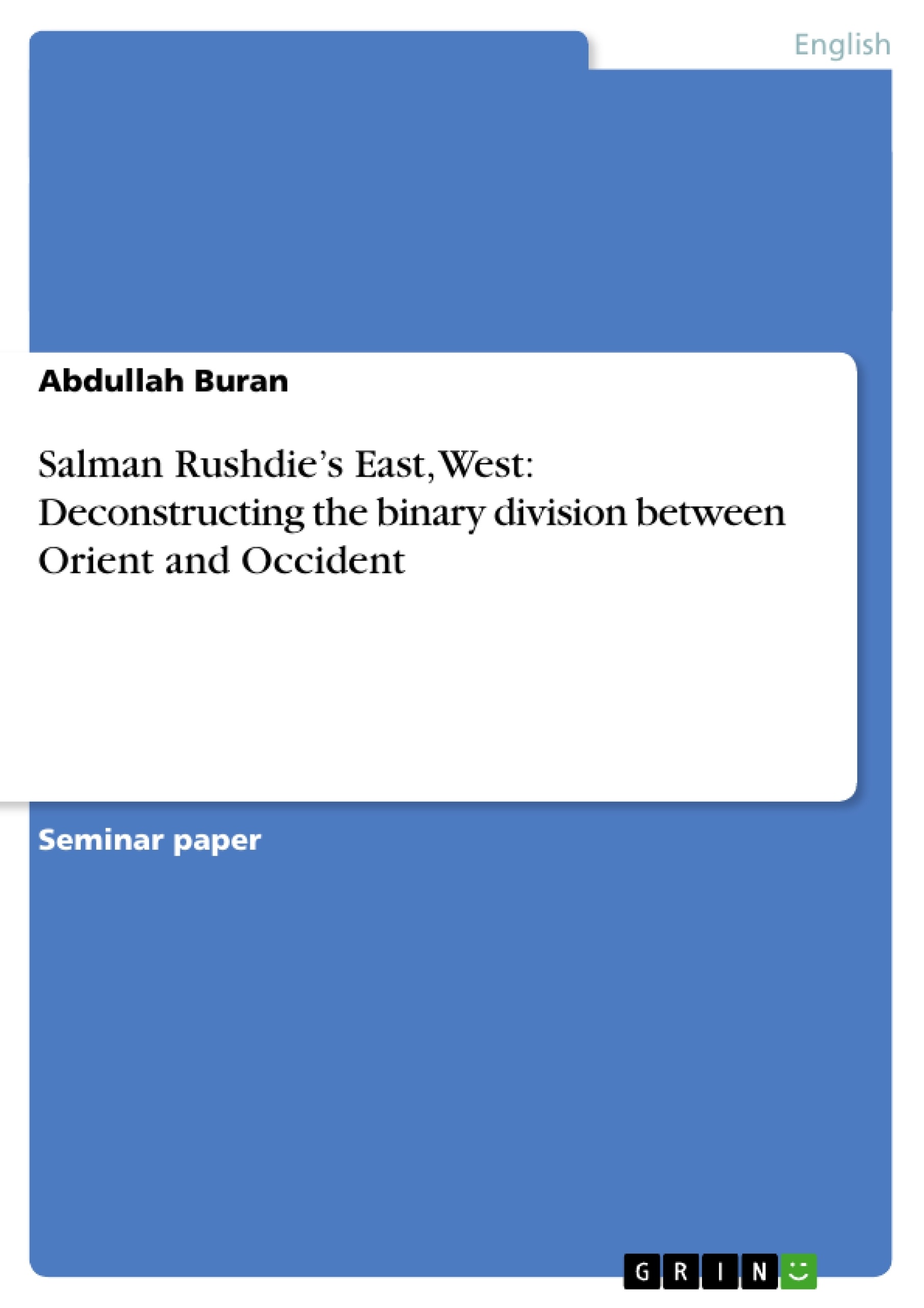1. Introduction
While reading the title of Rushdie’s short story cycle East, West a very important question arises in the reader’s mind: does Rushdie use the comma in between the title to show the binary division of the Orient and Occident or does he want to make a bridge between East and West (Homeless Is Where the Art Is 162)?
However, after in depth research on this book, it becomes clear that Rushdie goes even further than this bridging device. He not only tries to connect or mediate both the East and West, but as a traveller and migrant himself, he pokes fun at the traditional notions of Orient and Occident, employing a vast range of styles, genres, structures and techniques, finally deconstructing the binary division between East and West.
In doing so, he subverts the reader’s traditional assumptions about the Orient and Occident and clarifies that, in today’s reality; the East and West cannot be described in such a simplistic way anymore.
In Imaginary Homelands, Rushdie writes that “literature is, of all the arts, the one best suited to challenging absolutes of all kinds” (Beck: 356) this is precisely what happens in his short story cycle East, West. Nothing is “sacred” any longer, hence most of the stories in East, West can be regarded as examinations to provoke and deconstruct the inviolable of Eastern and Western culture (Beck 360).
To summarise, Rushdie mocks absolutist concepts of the oriental and occidental systems. By criticizing and deconstructing traditional notions he points out that, within the global village, the East and West are closely interrelated and cannot be regarded as opposites. Rushdie goes far beyond the familiar row about the binary division of the Orient and Occident.
Although the short stories in East, West on the one hand embrace this deconstructive design and on the other depict the abundance and manifoldness of human existence in the Orient and Occident, they do not provide easy interpretations.
This term paper attempts to determine the way Rushdie criticizes and deconstructs the traditional concepts and prejudices regarding the Orient and Occident and the way in which he disassembles these false images. The thesis that Rushdie deconstructs the binary division between the East and the West and displays the world as an intricate, interrelated system will be the main focus of this paper.
Two stories from the East part of his short story cycle East, West; Good Advice Is Rarer than Rubies, The Prophet’s Hair one...
Table of Contents
- Introduction
- East
- Good Advice Is Rarer than Rubies – Deconstructing the binary division
- The Prophet's Hair - Deconstructing the binary division
- West
- At the Auction of the Ruby Slippers - Deconstructing the binary division
- East, West
- The Courter-deconstructing the binary division
- Conclusion
Objectives and Key Themes
This paper examines Salman Rushdie's short story cycle *East, West*, specifically focusing on how he deconstructs the traditional binary division between the Orient and Occident. The main objective is to analyze how Rushdie subverts stereotypes and assumptions surrounding these cultural identities. Key themes explored in the paper include:- Deconstructing the binary division between East and West
- Challenging traditional notions of the Orient and Occident
- Exploring the interconnectedness of East and West in a globalized world
- The use of literary techniques to subvert reader expectations
- The complexities of identity and cultural hybridity
Chapter Summaries
This section will provide summaries of the chapters, focusing on the main themes, arguments, or narrative elements of each chapter. The Introduction establishes the context of Rushdie's work and introduces the central thesis that he deconstructs the binary division between East and West. It examines the title *East, West* and the way in which Rushdie uses it to challenge traditional assumptions about the Orient and Occident. The introduction also outlines the specific stories that will be analyzed in the paper, namely "Good Advice Is Rarer than Rubies," "The Prophet's Hair," "At the Auction of the Ruby Slippers," and "The Courter." The chapter "Good Advice Is Rarer than Rubies" analyzes the story of Miss Rehana, a young woman from the Orient, and her decision to stay in her home country rather than move to England. This chapter examines how Rushdie uses the story to challenge stereotypes about women from the Orient and their supposed desire to escape to the West. The chapter "The Prophet's Hair" delves into the story of a Muslim man who experiences a series of events that lead him to question his religious beliefs. This chapter explores the themes of faith, doubt, and the complexities of identity in a globalized world. The chapter "At the Auction of the Ruby Slippers" examines the story of a woman who travels to the West and experiences both its allure and its challenges. This chapter explores the themes of immigration, assimilation, and the search for identity in a new culture. The chapter "The Courter" focuses on a story that explores the intersection of East and West through the relationship between a young Indian man and an American woman. This chapter examines themes of cultural exchange, love, and the challenges of navigating different cultural identities.Keywords
This paper focuses on the themes of cultural identity, postcolonialism, orientalism, and deconstruction in the context of Salman Rushdie's short story cycle *East, West*. Key terms and concepts explored include: binary division, East and West, Orient and Occident, stereotypes, hybridity, global village, and interconnectedness. The paper also examines Rushdie's literary techniques, such as the use of humor, satire, and irony, to subvert traditional notions of the East and West.- Citar trabajo
- Abdullah Buran (Autor), 2009, Salman Rushdie’s East, West: Deconstructing the binary division between Orient and Occident, Múnich, GRIN Verlag, https://www.grin.com/document/138688




